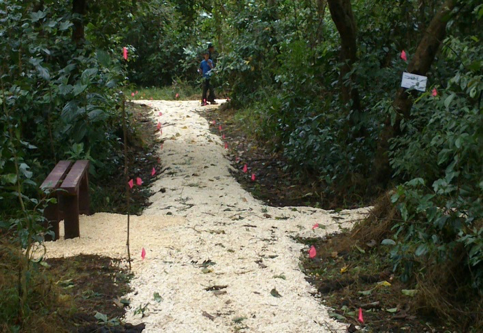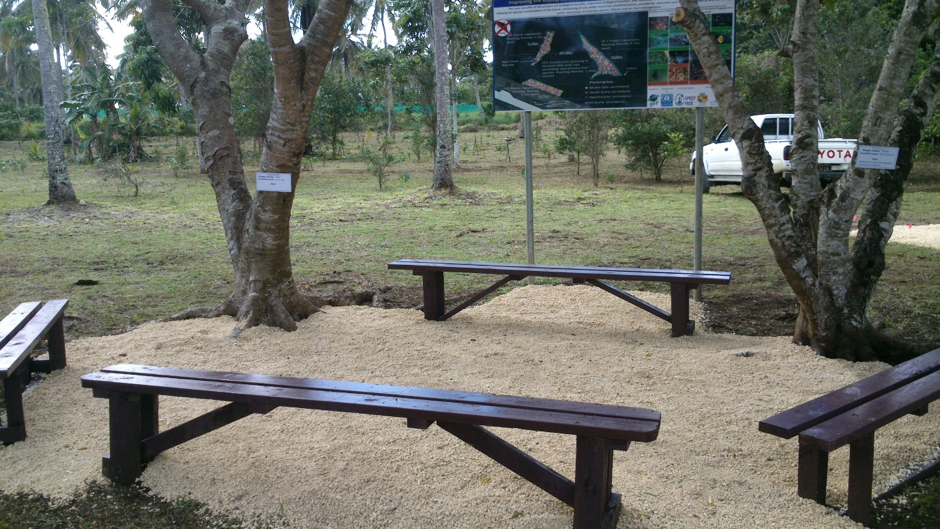
Biodiversity Conservation
The Toloa Rainforest received royal visitors during the commemoration of the 150th Anniversary of Tupou College. His Majesty King Tupou VI and Her Majesty Queen Nanasipau'u of the Kingdom of Tonga saw firsthand the positive impacts of an extensive invasive species program underway.
Students and teachers of Tupou College have worked to help protect species and manage the invasive species in the rainforest in partnership with the Ministry of Meteorology, Energy, Information, Disaster Management, Environment, Climate Change and Communications (MEIDECC) and the Secretariat of the Pacific Regional Environment Programme (SPREP).
 His Majesty King Tupou VI and Her Majesty Queen Nanasipau'u during their visit to Toloa Rainforest. Photo: MEIDECC
His Majesty King Tupou VI and Her Majesty Queen Nanasipau'u during their visit to Toloa Rainforest. Photo: MEIDECC
The Deputy Prime Minister and Minister for MEIDECC Hon. Siaosi Sovaleni, the Chief Executive Officer of MEIDECC Mr. Paula Ma'u, the Principal of Tupou College and Senior Ministry Officers welcomed the King and Queen to the Toloa Rainforest providing them with a guided tour.
"Battling invasive species in the Toloa Rainforest is the key element to help restore it. This will improve the ecological functioning and resilience of the Toloa Rainforest, and we are very pleased by the positive outcomes from the hard work of all involved," said Mr. David Moverley, the Invasive Species Adviser at SPREP.
"It is such an honour for us all to have welcomed the King and Queen to the Toloa Rainforest."
Invasive species management activities at the Toloa Rainforest are part of the Global Environment Facility – Pacific Alliance for Sustainability project to address invasive species across the Pacific island region. Work in Tonga is led by MEIDECC through their Environment Department in collaboration with national partners and UNEP, the implementing agency, and SPREP, the executing agency.
 A trail leading into Toloa Rainforest. Photo: MEIDECC
A trail leading into Toloa Rainforest. Photo: MEIDECC
Restoration efforts underway include a rat control program for the whole forest in order to save native bird and plant species. The bait stations are checked on a monthly basis for replacement.
Replanting of native trees in the rainforest began in 2014 to improve structure and size and to reintroduce plant species that have gone extinct within the forest. Planting will continue until the extension of the forest is complete.
A key aspect of the project is making information readily available for people who visit the forest, and many of these informational products explain native tree species, including the location of the flying fox colony. A trail almost 500 meters long, along with wooden chairs for rest stops throughout, has also been developed. The trail ranges from one meters to two meters in width throughout different parts of the Toloa Rainforest.
A special billboard has also been installed as the key focus of information about the Toloa Rainorest and the invasive species that threaten it.
"These will help raise awareness of our beautiful native trees and encourage people to take ownership of our environment," said Viliami Hakaumotu, Invasive Species Coordinator.
 Information benches at the Toloa Rainforest. Photo: MEIDECC
Information benches at the Toloa Rainforest. Photo: MEIDECC
"It will also help school students with their studies as they learn more about the native species in Tonga; we are very pleased to help encourage our future generation to learn more about our environment in Tonga."
The Government of Tonga under MEIDECC, through the Environment Department, will continue to work collaboratively with Tupou College on the protection of native species and management of invasive species in the rainforest.
This work is made possible with the financial assistance from the Global Environment Facility (GEF), through the United Nations Environment Programme (UNEP), and technical assistance from the Secretariat for the Pacific Regional Environment Programme (SPREP).
Students and teachers of Tupou College have worked to help protect species and manage the invasive species in the rainforest in partnership with the Ministry of Meteorology, Energy, Information, Disaster Management, Environment, Climate Change and Communications (MEIDECC) and the Secretariat of the Pacific Regional Environment Programme (SPREP).
 His Majesty King Tupou VI and Her Majesty Queen Nanasipau'u during their visit to Toloa Rainforest. Photo: MEIDECC
His Majesty King Tupou VI and Her Majesty Queen Nanasipau'u during their visit to Toloa Rainforest. Photo: MEIDECCThe Deputy Prime Minister and Minister for MEIDECC Hon. Siaosi Sovaleni, the Chief Executive Officer of MEIDECC Mr. Paula Ma'u, the Principal of Tupou College and Senior Ministry Officers welcomed the King and Queen to the Toloa Rainforest providing them with a guided tour.
"Battling invasive species in the Toloa Rainforest is the key element to help restore it. This will improve the ecological functioning and resilience of the Toloa Rainforest, and we are very pleased by the positive outcomes from the hard work of all involved," said Mr. David Moverley, the Invasive Species Adviser at SPREP.
"It is such an honour for us all to have welcomed the King and Queen to the Toloa Rainforest."
Invasive species management activities at the Toloa Rainforest are part of the Global Environment Facility – Pacific Alliance for Sustainability project to address invasive species across the Pacific island region. Work in Tonga is led by MEIDECC through their Environment Department in collaboration with national partners and UNEP, the implementing agency, and SPREP, the executing agency.
 A trail leading into Toloa Rainforest. Photo: MEIDECC
A trail leading into Toloa Rainforest. Photo: MEIDECCRestoration efforts underway include a rat control program for the whole forest in order to save native bird and plant species. The bait stations are checked on a monthly basis for replacement.
Replanting of native trees in the rainforest began in 2014 to improve structure and size and to reintroduce plant species that have gone extinct within the forest. Planting will continue until the extension of the forest is complete.
A key aspect of the project is making information readily available for people who visit the forest, and many of these informational products explain native tree species, including the location of the flying fox colony. A trail almost 500 meters long, along with wooden chairs for rest stops throughout, has also been developed. The trail ranges from one meters to two meters in width throughout different parts of the Toloa Rainforest.
A special billboard has also been installed as the key focus of information about the Toloa Rainorest and the invasive species that threaten it.
"These will help raise awareness of our beautiful native trees and encourage people to take ownership of our environment," said Viliami Hakaumotu, Invasive Species Coordinator.
 Information benches at the Toloa Rainforest. Photo: MEIDECC
Information benches at the Toloa Rainforest. Photo: MEIDECC"It will also help school students with their studies as they learn more about the native species in Tonga; we are very pleased to help encourage our future generation to learn more about our environment in Tonga."
The Government of Tonga under MEIDECC, through the Environment Department, will continue to work collaboratively with Tupou College on the protection of native species and management of invasive species in the rainforest.
This work is made possible with the financial assistance from the Global Environment Facility (GEF), through the United Nations Environment Programme (UNEP), and technical assistance from the Secretariat for the Pacific Regional Environment Programme (SPREP).